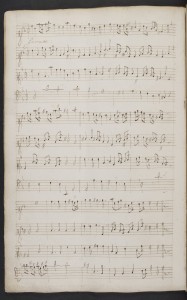
At some point after the Chelsea performances, Blow subjected the score of Venus and Adonis to further and more extensive reworking; the fact that there were at least two phases of revision indicates that instead of going to the trouble of recopying the score, he simply altered the existing autograph, and it seems likely that at one or two points he entered a revised reading without deleting the original one, leaving his intentions unclear. The most substantial change is that the entire sequence of courtly dances at the end of Act II is cut, severing the work from the masquing tradition that had given birth to it. Also cut is a short linking passage for continuo just before the final lament, though elsewhere a similar link is inserted; a short echo phrase for continuo only and an extra bar are inserted into the dialogue between Venus and Adonis in Act I, and a couple of bars into the Tune for Flutes at the end of the Prologue. Revisions affecting detail rather than structure are very much more numerous.

The librettist of Venus and Adonis has very recently been identified by James Winn as Anne Kingsmill, subsequently married as Anne Finch, who in the early 1680s was one of the Maids of Honour to Maria Beatrice of Modena, Duchess of York. It was evidently at the behest of the Duchess – a music-lover, and one whose sophisticated taste ran to opera in particular – that the production of Calisto, the only other full-scale court masque in the reign of Charles II, had taken place in 1675. Like that work Venus and Adonis adopts a classical myth, features pastoral lovers, and focuses on female characters. He further notes that much of the second act of Venus and Adonis, which is unconnected with the myth, instead directly portrays the duties and interests of the Maids of Honour (represented in the masque by the Graces).

The reason the distinctive obbligato recorder part in John Blow’s Venus and Adonis is confined to twining itself around the sensuous phrases in which Venus describes her amatory techniques may be nothing more than the erotic associations of the instrument, but it is perhaps also relevant that in 1686 Jacques Paisible, who played the part married Moll Davies, the actress who played Venus. If the two of them already had a blossoming relationship when the opera was first produced, this feature of its scoring would have had the court audience chuckling over yet another private joke – one not even requiring words.

The principal manuscript source of Venus and Adonis in its original version is British Library, Add. MS 22100, a handsome presentation score-book copied by John Walter, organist of Eton College, who headed the work “A Masque for ye Entertainment of ye King”. Annotations in a different hand record the fact that Venus was sung by “Mrs Davys” and Cupid by Lady Mary Tudor. (Mary or Moll Davies was a former singing actress, who in 1667 had taken the part of Ariel in Dryden and Davenant’s radically revised version of Shakespeare’s The Tempest, and who had retired from the stage in the following year; she had also been one of the king’s mistresses, and Lady Mary Tudor was her natural daughter by the king – one of his numerous by-blows.)




